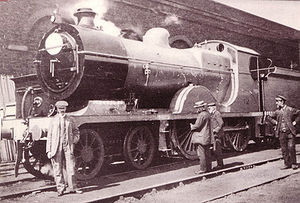SECR L and SR L1 classes
| SECR L class |

L Class at Ashford shortly after delivery from the manufacturers
|
| Type and origin |
| Power type |
Steam |
| Designer |
Wainwright (with later alterations by Maunsell) |
| Builder |
|
| Build date |
1914 |
| Total produced |
22 |
|
| Specifications |
Configuration:
|
|
| • Whyte
|
4-4-0 |
| • UIC
|
2′B h2 |
| Gauge |
4 ft 8 1⁄2 in (1,435 mm) |
| Leading dia. |
3 ft 7 in (1,090 mm) |
|
Driver dia. |
6 ft 8 in (2,030 mm) |
| Loco weight |
57 long tons 9 cwt (128,700 lb or 58.4 t) |
| Tender weight |
40 long tons 6 cwt (90,300 lb or 40.9 t) |
| Fuel type |
Coal |
Firebox:
• Firegrate area |
22 1⁄2 sq ft (2.09 m2) |
| Boiler pressure |
- New: 160 lbf/in2 (1.10 MPa)
- later: 180 lbf/in2 (1.24 MPa)
|
| Cylinders |
Two, inside |
| Cylinder size |
- New: 20 1⁄2 in × 26 in (520 mm × 660 mm)
- later 19 1⁄2 in × 26 in (500 mm × 660 mm)
|
| Valve type |
9-inch (229 mm) piston valves |
|
|
|
| Career |
| Operators |
|
| Class |
SECR/SR: L |
| Numbers |
- SECR: 760–781
- → SR: A760–A781
- → 1760–1781
- → BR: 31760–31781
|
| Withdrawn |
1956–1961 |
| Disposition |
All scrapped |
|
| Type and origin |
| Power type |
Steam |
| Designer |
Wainwright (with later alterations by Maunsell) |
| Builder |
|
| Build date |
1914 |
| Total produced |
22 |
| Specifications |
Configuration:
|
|
| • Whyte
|
4-4-0 |
| • UIC
|
2′B h2 |
| Gauge |
4 ft 8 1⁄2 in (1,435 mm) |
| Leading dia. |
3 ft 7 in (1,090 mm) |
|
Driver dia. |
6 ft 8 in (2,030 mm) |
| Loco weight |
57 long tons 9 cwt (128,700 lb or 58.4 t) |
| Tender weight |
40 long tons 6 cwt (90,300 lb or 40.9 t) |
| Fuel type |
Coal |
Firebox:
• Firegrate area |
22 1⁄2 sq ft (2.09 m2) |
| Boiler pressure |
- New: 160 lbf/in2 (1.10 MPa)
- later: 180 lbf/in2 (1.24 MPa)
|
| Cylinders |
Two, inside |
| Cylinder size |
- New: 20 1⁄2 in × 26 in (520 mm × 660 mm)
- later 19 1⁄2 in × 26 in (500 mm × 660 mm)
|
| Valve type |
9-inch (229 mm) piston valves |
| Career |
| Operators |
|
| Class |
SECR/SR: L |
| Numbers |
- SECR: 760–781
- → SR: A760–A781
- → 1760–1781
- → BR: 31760–31781
|
| Withdrawn |
1956–1961 |
| Disposition |
All scrapped |
The SECR L class was a class of 4-4-0 steam tender locomotive built for express passenger service on the South Eastern and Chatham Railway. Although designed by Harry Wainwright, they were built during the Maunsell era.
The South Eastern and Chatham Railway (SECR) was an amalgamation of two competing companies, the South Eastern Railway (SER) and the London Chatham and Dover Railway (LCDR) which took place in 1899. One of the first tasks of Harry Wainwright, the new Chief Mechanical Engineer was to introduce a series of standardised locomotives which would operate on both railways, but the LCDR main line was more lightly engineered and subject to more severe weight restrictions than that of the SER. At the same time the Board of Directors was anxious to reap some of the financial benefits of amalgamation by closing the LCDR Longhedge Railway Works.
During the first years of the SECR, express passenger services were well served by Wainwright's 'D' and 'E' 4-4-0 classes but loads continued to increase and by 1912 the designer realised that he would soon need more powerful locomotives. Unfortunately weight restrictions of the LCDR main line prevented the use of any significantly larger or more powerful locomotive and the cost of strengthening the bridges on this line was prohibitively expensive. The Board of Directors therefore ordered Wainwright to prepare a design for only for the SER main line services. Wainwright's original design was criticised by the Directors for the use of saturated steam and slide valves, both of which were considered old fashioned in the 20th century. These criticisms of Wainwright coincided with an acute motive power crisis on the railway during the summer of 1913, (due in part to the Directors' insistence on the premature closure of Longhedge Works and the inability of Ashford railway works to cope with the increased workload). As a result, Wainwright was asked to retire on 30 November 1913, before the new locomotives could be ordered.
...
Wikipedia

